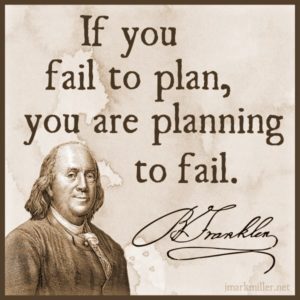 “Plan the work, work the plan” where the wise words of a previous manager. They reminded me of the quote from Ben Franklin: “If you fail to plan, you are planning to fail.” This concept is well cemented in my brain. This is what I do at work everyday, in spite of that I was not applying it to my biggest project: my life. Shouldn’t there be a case to have a life plan? I had gone about my life using a checklist at best or nothing at worst. I was not giving enough time to planning my week, my month, my year, my life. I was planning to fail amidst successful plans at work.
“Plan the work, work the plan” where the wise words of a previous manager. They reminded me of the quote from Ben Franklin: “If you fail to plan, you are planning to fail.” This concept is well cemented in my brain. This is what I do at work everyday, in spite of that I was not applying it to my biggest project: my life. Shouldn’t there be a case to have a life plan? I had gone about my life using a checklist at best or nothing at worst. I was not giving enough time to planning my week, my month, my year, my life. I was planning to fail amidst successful plans at work.At the end of 2017 I began to apply business principles to my personal life. I came across an advertisement for a planner, and the first words caught my eye: “What do you want to leave behind this year?” The question took me back and really made me pause. I wanted to answer the question quickly and move one, but I couldn’t. The question stayed with me for several weeks. New Year’s Day came and I wrote down my goals as I always did, yet I still couldn’t answer the question. The first week this year I set aside one day to come up with a good answer to the question.
After two days of soul searching, I had an answer and a plan. This year I wanted, above all, for my daughter to have a conscious and memorable baptism. I was also able to create meaningful desires for all the aspects in my life. I wanted to succeed as a husband, father, employee, manager, professional, mentor, disciple of Christ, and human. I was not only enlighten by this experience, but hungry for further introspection, planning, execution, and results. I set apart two hours each week to plan my week, four hours each month to plan the month, and two days each year to plan next year. I planned 2018 by setting goals for each of the roles in my life. I recorded all these goals in a note to be evaluated during each of my monthly planning sessions.
In my four hour monthly planning for January I analyzed which goals needed to be started, advanced, or completed that month. I put specific actions that needed to be taken during that month and the week that needed to happen. Many tasks were full actions others were more vague and required further thought at certain points in the month. It took me less than four hours to plan the month and I was able to plan the first week. I made sure I understood all the tasks needed to complete the monthly goals. I assigned a specific day in the week when I was going to complete the work. I only assigned work Monday through Thursday to be able to catch up on in-week tasks on Friday.
As of this writing I’ve completed five weeks of planning and execution. I have also done February’s monthly planning. I cannot lie, it felt completely overwhelming the amount of things I needed to do each day. Gone were the days of just working on one or two initiatives. I felt like I was sprinting all the time, moving from one item to the next. After a couple of weeks while I was writing my thoughts about the prior week I noticed that I had completed more than half of the items I had set out to do in January. A sense of pride and satisfaction overcame me, I had moved the proverbial needle significantly and visibly. I realized that I could be on sprint mode because I had taken all the fluff out of my days. Instead of having multiple times of “what do I have to do now?” I crunched them into a few hours each month and week, and then I could just run. I had replaced all my planned failures into successful planning.
Photo by JESHOOTS.COM on Unsplash


